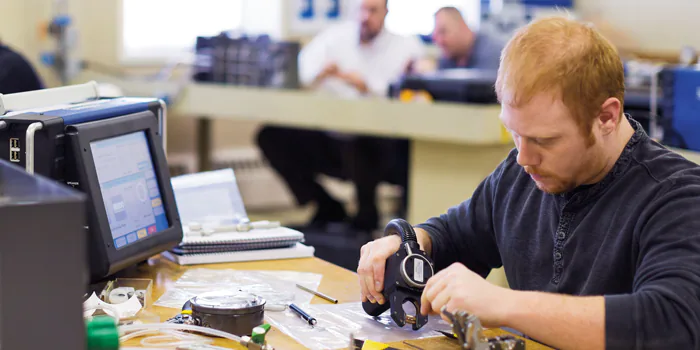Share this
Selecting Orbital Welding Training: Tips on Finding the Right Program in Northern California
by Malik Durojaiye on 4/26/22 9:00 AM

Orbital welding is the most efficient method for operators—compared to manual TIG welding—to achieve consistent weld quality for critical systems, especially when working with a limited workspace. Amongst other industries, the frequency of such critical weld systems is more common in refineries. To keep up with the rising demand for sophisticated production requirements, it has become imperative to add skilled orbital welders to the team. However, with the passage of time, orbital welding equipment has evolved to be more complicated than manual TIG setup. A simple orbital welding job can go wrong in a thousand different ways unless your operators have received orbital welding training and tips from experts.
Training to develop advanced orbital welding skills can help your employees achieve weld consistency and reliability. However, the real challenge is to find the right partner to meet training goals with ease. Let’s have a look at some of the essential elements within an orbital welding training program to help you make the right choice.
Orbital Welding Training: Tips on Selecting an Ideal Training Partner
Make sure your training partner stands tall on the following requirements.
Certified and Experienced Instructors
Training under learned industry experts always pays off. They use their field experience with technicians, operators, mechanics, and engineers to better train your associates. If they are trained by a reputable supplier, that’s an added bonus. However, when it comes to orbital welding, apart from experience, certification by a trustworthy organization also matters. It helps experts build elevated knowledge that transfers into skills in the field.
Continuous Learning…Even After Training Is Complete
Learning doesn’t stop once training is over. It’s a continuous process. Your employees will learn through different stages of orbital welding, periodically encountering challenges. A partner that provides ongoing learning and support—even after training ends—would help overcome these challenges. Periodic sessions or weekly meetings with instructors post-training can help employees clear doubts and excite them to dive deeper.
Hands-on Practical Activities
A hands-on approach is a powerful way to help trainees learn, apply, and practice their new orbital welding skills in a safe environment. Trainees tend to soak in more knowledge when they take an active role in the learning than typically listening to lectures and forgetting. For instance, lectures don’t guarantee that trainees will have the knowledge retention to troubleshoot an unstable arc. But, having them participate in learning experiences similar to an actual situation can help them have a better understanding of how to identify the root cause.
Typically, an ideal training program must devote 30% of the course time to practical application. To ensure even better knowledge transfer, the instructor should utilize every opportunity to spend one-to-one time with each employee during the course.
Preferably an Equipment Manufacturer
Orbital welding training under local equipment manufacturers can benefit your employees in more ways than one. First, it will save you time and costs associated with employees' lodging, boarding, and other arrangements necessary for a distant training center. Second, manufacturers who conduct the training can better advise on how to overcome hidden challenges that their products may present. Third, your employees can rely on a quick response from a local trainer in case of any operational emergency arises.
Choose the Swagelok M200 Orbital Weld System Training Course
Swagelok is a well-known brand in the fluid industry, designing high-quality fluid system products since 1947. As a responsible manufacturer, Swagelok offers a five-day intense, customized orbital welding (GTAW) course that aims to create a pool of skilled welders to benefit Northern California refineries. The course teaches how to acquire precision and consistency in orbital welding using the Swagelok® M200 welding system.
The course is run by veteran instructors qualified at an Inspector (CWI) or an Educator (CWE) level with the industry expertise of more than five years. They combine traditional classroom teachings with hands-on field experiences to help trainees clear fundamental gaps with ease. The program also offers training to guide your operators long after the training ends. Our training program helps Northern California refineries save time and resources and achieve improved employee morale at the same time. With customized course content and certified experienced instructors, your employees get to know all critical aspects of orbital welding that skilled welders learn from years of experience.
To find out more about how Swagelok Northern California can be your ideal partner for offering bespoke orbital welding training and tips for your employees, contact our team today by calling 510-933-6200.

About Malik Durojaiye | Field Engineer, Assembly Services
Malik Durojaiye began his Swagelok career in 2019 as a Custom Solutions Engineer in our Assembly Services group. Prior to Swagelok, Malik developed as a design engineer as well as a manufacturing engineer for 6 years serving Kentucky and California with Altec Industries; a leading provider of products and services to the electric utility, telecommunications, tree care, lights and signs, and contractor markets.
Share this
- Archive (465)
- Assembly Services (207)
- About (100)
- Seal Support Systems (96)
- Best Practices (88)
- Training Services (74)
- Fittings (51)
- Semiconductor Applications (49)
- Hoses and Flexible Tubing (47)
- Regulators (44)
- Tubing (42)
- Grab Sampling Systems (32)
- Sampling Systems (32)
- Gas Systems (30)
- Services (30)
- Downloads (29)
- Valves (24)
- Application Support (18)
- Orbital Welding (17)
- Case Studies (13)
- Steam Systems (13)
- Frequently Asked Questions (12)
- Tools (12)
- Measurement Devices (7)
- Subsystems (6)
- Thermal Management (6)
- September 2023 (1)
- August 2023 (2)
- June 2023 (1)
- March 2023 (3)
- February 2023 (3)
- January 2023 (4)
- December 2022 (4)
- November 2022 (4)
- October 2022 (4)
- September 2022 (1)
- August 2022 (3)
- July 2022 (2)
- June 2022 (4)
- May 2022 (1)
- April 2022 (2)
- March 2022 (1)
- February 2022 (2)
- January 2022 (3)
- December 2021 (1)
- November 2021 (6)
- October 2021 (6)
- September 2021 (8)
- August 2021 (4)
- July 2021 (3)
- June 2021 (6)
- May 2021 (6)
- April 2021 (7)
- March 2021 (5)
- February 2021 (4)
- January 2021 (6)
- December 2020 (5)
- November 2020 (6)
- October 2020 (6)
- September 2020 (8)
- August 2020 (7)
- July 2020 (8)
- June 2020 (8)
- May 2020 (6)
- April 2020 (9)
- March 2020 (7)
- February 2020 (10)
- January 2020 (21)
- December 2019 (23)
- November 2019 (21)
- October 2019 (22)
- September 2019 (21)
- August 2019 (22)
- July 2019 (23)
- June 2019 (20)
- May 2019 (23)
- April 2019 (22)
- March 2019 (21)
- February 2019 (20)
- January 2019 (21)
- December 2018 (14)
- November 2018 (19)
- October 2018 (23)
- September 2018 (17)
- August 2018 (29)
- July 2018 (11)
- June 2018 (6)
- May 2018 (5)
- April 2018 (4)
- March 2018 (5)
- February 2018 (3)
- January 2018 (3)
- December 2017 (2)
- November 2017 (4)
- October 2017 (3)
- September 2017 (2)
- August 2017 (6)
- July 2017 (4)
- June 2017 (4)
- May 2017 (4)
- April 2017 (3)
- March 2017 (4)
- February 2017 (3)
- January 2017 (3)
- December 2016 (3)
- November 2016 (3)
- October 2016 (3)
- September 2016 (5)
- August 2016 (5)
- July 2016 (4)
- June 2016 (5)
- May 2016 (3)
- April 2016 (4)
- March 2016 (5)
- February 2016 (11)
- January 2016 (1)
- December 2015 (3)
- November 2015 (4)
- October 2015 (3)
- September 2015 (4)
- August 2015 (4)
- July 2015 (8)
- June 2015 (5)
- May 2015 (3)
- April 2015 (4)
- March 2015 (4)
- February 2015 (3)
- January 2015 (4)
- December 2014 (2)
- November 2014 (3)
- October 2014 (4)
- September 2014 (4)
- August 2014 (4)
- July 2014 (5)
- June 2014 (4)
- May 2014 (4)
- April 2014 (5)
- March 2014 (4)
- February 2014 (3)
- January 2014 (4)
- December 2013 (5)
- November 2013 (3)
- October 2013 (4)
- September 2013 (3)
- August 2013 (5)
- July 2013 (5)
- June 2013 (5)
- May 2013 (3)
- April 2013 (6)
- March 2013 (4)
- February 2013 (4)
- January 2013 (8)
- December 2012 (4)
- November 2012 (6)
- October 2012 (6)
- September 2012 (4)
- August 2012 (4)
- July 2012 (4)
- June 2012 (4)

.webp?width=210&height=70&name=StickyLogo%20(5).webp)